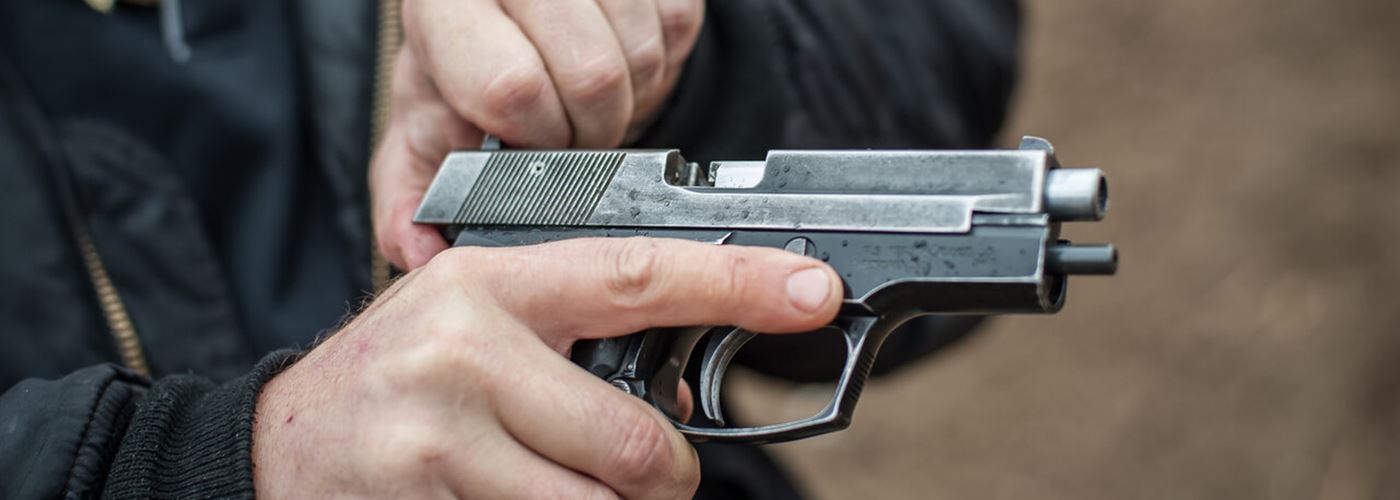
Malfunctions are completely avoidable with correct inspection and replacement of worn parts. Inspection is done while cleaning your pistol. Cleaning is done after field stripping your pistol. You, the user, should only be field stripping your pistol. Leave the disassembly of your pistol to a competent gunsmith. Otherwise, you may lose small springs and other parts. In a worst-case scenario, you will incorrectly assemble your pistol, causing the pistol not to function as designed. If you lose a small spring that is part of a safety mechanism, you probably won’t be able to buy a replacement spring. The manufacturer will require you to ship the pistol back to them so they can install the replacement spring. How would I know that?
Type 1 pistol malfunction
A Type 1 pistol malfunction is a failure to fire, which occurs when pressing the trigger makes a click instead of a bang. The solution is immediate action, which means:
- Tap the magazine base plate at the bottom of the grip to ensure the magazine is locked into the pistol.
- Rack the slide to chamber the next cartridge from the magazine.
- Assess the situation. If you were taught Tap-Rack-Bang, that’s just wrong! Never let shooting the pistol become an automatic part of any procedure. The shooting must always be a separate intellectual decision. Otherwise, you will shoot faster than you can think, which always leads to tragic consequences. Shooting on every presentation from your holster to the target is a training scar that will get you into trouble. If you testify at trial that that was how you were trained, it’s not going to go well for you. Because that is obsolete training.
Type 2 pistol malfunction
A Type 2 pistol malfunction is a failure to feed (a cartridge into the chamber), which occurs when pressing the trigger does not cause a click (dead trigger). Immediate action will clear this malfunction. Do not analyze the symptoms to decide what to do. If the pistol does not fire, immediately execute immediate action. If the immediate action does not work, as will be obvious because the slide does not operate properly, you will immediately execute a type 3 malfunction clearing or a reload. A type 3 malfunction clearing will automatically fix an empty magazine problem. So, training yourself to automatically do a type 3 malfunction clearing will cost you a little more time than an emergency (reactive as opposed to a proactive) reload. Training to immediately execute an action is much faster than stopping to analyze. Because conscious thought is much slower than automatic motor programs.
type 3 malfunction
A type 3 malfunction is a failure to extract the spent case from the chamber. The symptom is a dead trigger, as with a type 2 malfunction.
This is not a double feed. Modern semi-auto pistols will not double feed as some semi-auto rifles will. Double feed means that two cartridges have come out of the magazine and the bolt or slide is attempting to insert both into the chamber at once.
A type 3 malfunction is where the extractor claw has not grabbed the rim of the spent case or slipped off the rim of the case, and the slide has moved backward without pulling the case out of the chamber. So, when the slide moves forward under the force of the recoil spring, it attempts to insert a new cartridge into the chamber, but the chamber is already occupied by the previous cartridge’s case.
The solution is:
- Lock the slide to the rear. (If you can rip the magazine out of the magazine well without locking the slide to the rear, you don’t have to do this step.)
- Eject the magazine. (Discard the magazine, as it may be the problem.)
- Rack the slide until the chamber is clear.
- Load the pistol.
The following photos are of a Springfield Armory XD in 45 ACP with a 4" barrel. The photos display type 2 malfunctions due to a weak magazine spring.

The cartridge is being driven down into the magazine rather than up into the chamber. Because the magazine spring had not pushed the cartridge up into the correct position against the magazine lips before the slide came forward and started pushing the cartridge forward.

The slide moved forward under the force of the recoil spring but caught the side of the case instead of the rear of the case. The slide was then locked back so you could see what happened. This occurred because the spring had not pushed the cartridge all the way up against the lips of the magazine before the slide came forward. So instead of catching the rear of the shell casing, it caught the side of the shell casing.

Old Springfield Armory spring on left of photo. New Wolff spring on right of photo.
So, why did the magazines work flawlessly in an XD Tactical with a 5" barrel and fail completely in an XD with a 4" barrel?
The longer barrel has a longer slide, which has more mass, and has a single 18.5-pound spring. The shorter barrel has a shorter slide, which is less massive, and has a much stiffer double spring (one spring wound clockwise around another spring wound counterclockwise).
So, the shorter-barreled pistol cycles much faster. The weak magazine springs could not push the cartridge up into the correct position for chambering the cartridge before the slide started moving forward.
